2018: A year of progress and change for California’s high-speed rail project
Posted: 6 December 2018 | Scott Jarvis (California High-Speed Rail Authority) | 11 comments
As construction continues at pace on California’s high-speed rail system, Chief Engineer at the California High-Speed Rail Authority, Scott Jarvis, shares the progress made to date on one of the most complex and far-reaching, public infrastructure projects in the United States – one that will not only transform rail travel for Californian’s, but a project that is creating jobs and positively impacting the state’s economy.
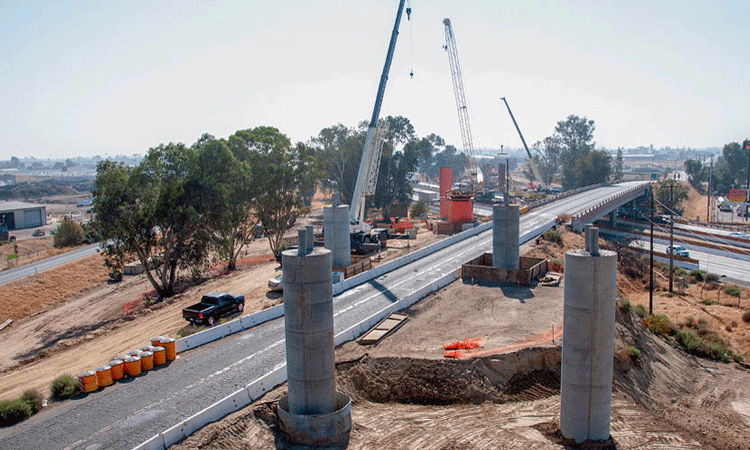

At the Cedar Viaduct, construction crews continue extending the structure across State Route 99 south of Fresno. Columns for several support piers are rising on both sides of the highway. The viaduct will eventually be connected to the smaller Muscat Viaduct a little further to the south. One of the largest structures on Construction Package 1, the Cedar Viaduct will be about three-quarters of a mile long when complete.
California has long set the pace for American rail
Its innovative spirit and willingness to invest in tomorrow is part of what makes California the economic powerhouse that it is. With a population of 40 million and a $2.5 trillion economy – the world’s fifth largest – California is taking bold steps today toward implementing the country’s first true high-speed rail system of tomorrow.
When Phase 1 of the California high-speed rail system opens, electric high-speed rail passenger trains will transport passengers from San Francisco through the Central Valley to Los Angeles and Anaheim in less than three hours at speeds capable of exceeding 200mph.
Compared to a car trip of at least six and a half hours in the best traffic, this new travel alternative will transform the way Californians move, live and work. Eventually it will stretch 800 miles and link to other highly populated mega-regions, extending as far north as Sacramento, the state’s capital, and farther south to San Diego.
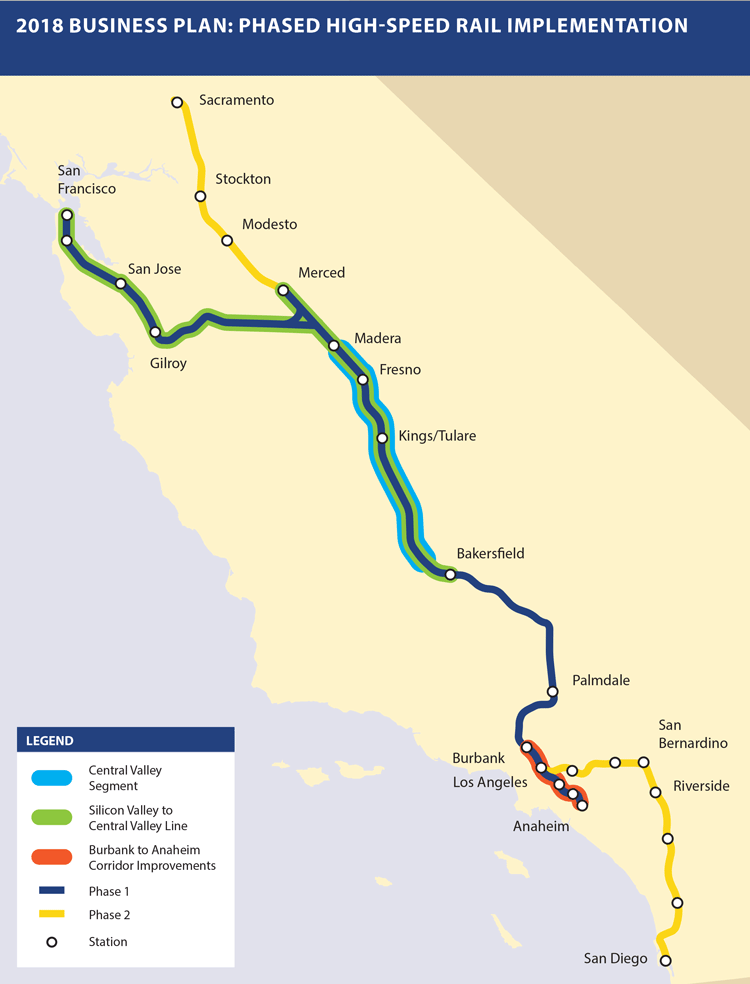

The current construction was made possible thanks in part to a $2.55 billion federal economic stimulus grant, awarded to the California High-Speed Rail Authority (Authority) in 2010 at the height of the worst economic recession since the Great Depression of the 1930s. Combined with other state and federal funds, the investment (including funds for local and regional rail lines) marked the beginning of the work to build the system approved by California voters in 2008.
The state has met the deadline to fully invest all the federal grant funds by 30 September 2017. It’s also drawn in hundreds of private sector firms (including small, disadvantaged and veteran-owned businesses) to begin construction in California’s Central Valley. As one of the largest public infrastructure projects in the country, the project has created thousands of good paying jobs and infused the state’s economy with billions of dollars.
2018: A year of progress and change for high-speed rail in California
In January, California Governor Edmond G. Brown Jr. renewed his pledge of support for the high-speed rail programme by prominently boosting the high-speed rail at his 16th and final State of the State Address in front of a joint session of lawmakers. He said: “I make no bones about it. I like trains and I like high-speed trains even better,”
At the time, Edmond highlighted the early economic benefits of construction, making the point that a high-speed rail system, while expensive to build, is still cheaper, more sustainable and more convenient than the price of expanding airports and building freeways. “It will be fast, quiet and powered by renewable electricity and last for a hundred years.”
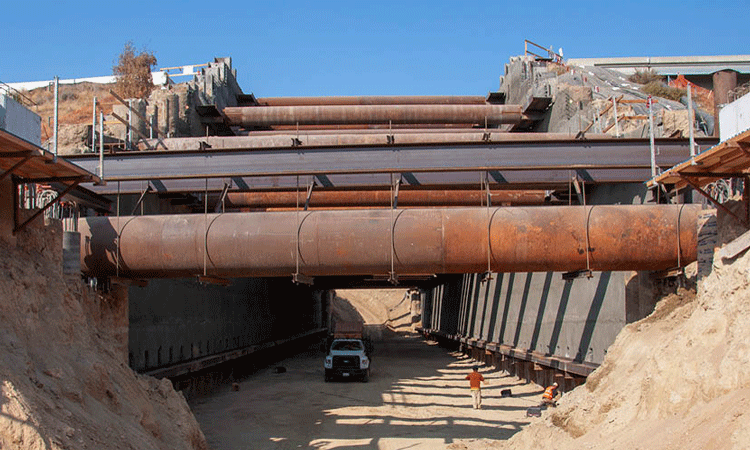

Workers continue excavating the crossing under State Route 180 (SR 180) outside of downtown Fresno. As they dig down five feet, they add to the retaining wall with a rebar mesh and sprayed concrete, known as shotcrete. There’s about 18 feet left to excavate before crews will construct a concrete box that will carry the trains under SR 180, a rail spur and the Dry Creek Canal. At the trench, to the north of the SR 180, additional precast struts have been set, approximately 800 feet have been partially excavated. Crews are installing temporary supports to excavate the remainder in this area of the trench. Ultimately, the trench will extend approximately one mile in length.
As the Authority transitioned from a planning to a project-delivery organisation, new leadership and organisational improvements have further been put into place. In February, Brian P. Kelly, widely considered the state’s top transportation policy executive, was selected as the Authority’s Chief Executive Officer. Prior to taking the helm, Brian served as Gov. Brown’s transportation czar, leading the California State Transportation Agency. Brian has in turn assembled a strong executive team, including Joseph Hedges, who has come aboard as Chief Operating Officer and Pamela Mizukami as the Chief Deputy Director.
A business plan for Californian high-speed rail
In May, the Authority Board of Directors adopted the 2018 Business Plan which outlined the system’s path forward, including steps to initiate high-speed rail service as soon as possible. By making concurrent investments to be linked over time, the Authority will work to construct additional segments as funding becomes available.
The 2018 Business Plan lays out an implementation strategy focused on meeting federal funding commitments by completing the 119-mile-long segment that’s under construction and completing the environmental review for all project segments statewide by 2022. While environmental work related to the Fresno to Bakersfield project section advanced in November of 2018, final environmental clearance for another major project section, the Central Valley Wye – a junction between the Central Valley and trains heading west to the San Francisco Bay Area, north to Merced and south to Fresno – is anticipated in the spring of 2019.
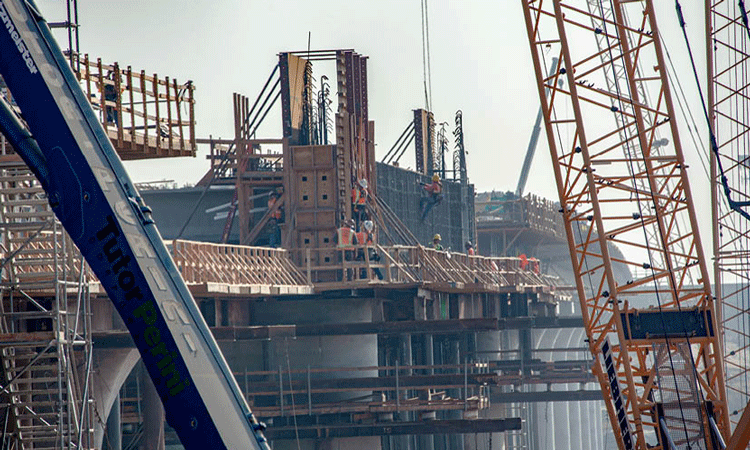

At the northern end of the San Joaquin River Viaduct, girders have been set and a cast-in-place concrete arch is underway for the section that crosses over the river. Concrete is being poured for the deck segments on the north side of the river, while further south, crews continue constructing barrier and intrusion protection walls along the sides of the pergola section of the viaduct. The completed viaduct, nearly a mile in length, will be one of the largest structures on this first phase of the high-speed rail project.
The 2018 Business Plans calls for extending the Silicon Valley to the Central Valley Line, which runs from San Francisco to Bakersfield and would generate high ridership and revenue. The impact of this line will be inestimable in terms of the economic impacts within each region. The line will enable people to connect and work at high-tech jobs in Silicon Valley and San Francisco while having greater access to more affordable housing options in Central Valley cities such as Gilroy and Fresno, which are already working on plans to create vibrant, livable districts around high-speed rail stations. These new connections will foster economic revitalisation, affordable housing and workforce development goals.
Meanwhile, the Authority will look toward introducing high-speed rail in Southern California and investing remaining ‘bookend funds’ in projects along that corridor. These projects will also improve freight, local and regional passenger rail service, transit connections and safety in the region.
Current progress on California’s high speed rail project
Crews are making steady progress in the Central Valley on what will be the future high-speed rail system’s midway point. More than two dozen active construction sites span 119 miles, as three design-build construction teams work on contracts valued at nearly $4 billion.
The first significant construction contract executed on the high-speed rail programme stretches 32 miles in the heart of the Central Valley and features 12 grade separations, two viaducts, one tunnel and a major river crossing. Major structures have already been completed, including the Tuolumne Street Bridge, which finished and opened to traffic in August of 2017. The bridge supports the revitalisation of Fresno (California’s fifth most populous city) by carrying two-way traffic in and out of the downtown, over future high-speed rail and freight tracks. Work is also complete on the Fresno River Viaduct, a 1,600ft-long bridge-like structure that will carry high-speed trains over the river and a two-lane highway.
Construction is also progressing at the San Joaquin River Viaduct and Pergola, a 4,740ft-long structure that spans a river and freight rail tracks parallel to a major multi-lane highway. This structure features curved arches representing the northern gateway into the city and a pergola structure to cross over the top of the freight rail tracks.
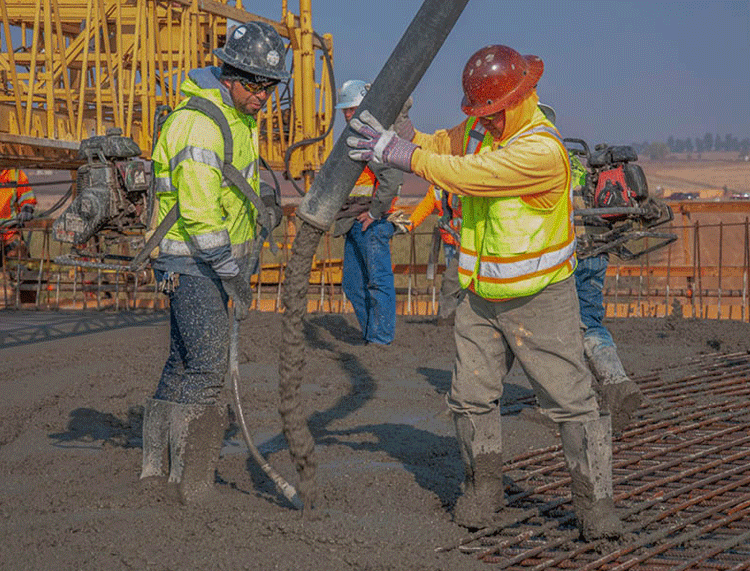

Crews have poured the concrete deck and are working on the back walls and traffic barrier for the bridge over the high-speed rail line at the Avenue 12 grade separation. The realignment of the busy roadway with two separate bridges will take traffic over the high-speed rail line and the BNSF freight tracks a little further east. To the east, rebar and carpenter crews continue to work on the cast in place wall footings adjacent to the structure which will cross over the BNSF freight rail tracks.
The second significant construction contract to be executed extends approximately 65 miles south of the terminus of the first construction package in Fresno and features approximately 36 grade separations, including viaducts, underpasses and overpasses. Construction activities have begun as crews have carried out geotechnical and demolition projects. They’ve also moved mountains of dirt while building embankments and conducting utility relocations.
A pre-cast facility built by the contract’s design-builder opened nearby over the summer. The facility is unique as it manufactures girders and pre-cast slabs, allowing the builder to make as many as eight girders at a time in order to expedite the bridge construction process. The facility will ultimately manufacture around 1,300 different kinds of beams and almost half a million pre-cast slabs.
The third and final construction contract extends 22 miles to the south. Major activities underway include utility relocation, clearing and grubbing, and geotechnical analysis as crews are testing the soil conditions for future construction of a viaduct that will carry high-speed trains over the highway.
High-speed rail construction creates jobs in California
Overall, this construction progress demonstrates how high-speed rail is making good on a promise to create jobs. In June, the Authority celebrated another major milestone when the project created its 2,000th construction job. Currently, there are more than 2,400 skilled labourers working on the project, as the Authority continues to move forward on environmental review and construction, working closely with its partners, local communities, stakeholders and policymakers at the local, state and federal levels.
With active construction sites, millions invested in small businesses and a business plan to pull it all together, the state’s high-speed rail programme is far from an idea; it’s a reality that in 2019 will push this transformative project farther ahead, connecting and transforming California.
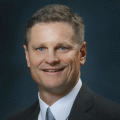
As the Chief Engineer for the California High-Speed Rail Authority, Scott Jarvis P.E. provides leadership, direction and oversight of programme management and engineering activities. During his more than five years with the Authority, Scott has played a key role in advancing the high-speed rail programme from concept and planning to full-scale construction. Over the previous 32 years, Scott has gained extensive background and knowledge in multiple areas of major infrastructure delivery. In addition to his time at the Authority, he spent over 26 years at the California Department of Transportation (Caltrans) and worked in several project delivery functions, with an emphasis in construction engineering and programme management. His management experience also includes serving as Caltrans’ Assistant Chief of Construction, in which he assisted the Chief of Construction in overseeing and executing the state-wide construction programme, which consisted of over 600 projects valued at over $12 billion. He held several other management positions at Caltrans’ Division of Construction, including Construction Field Coordinator, Chief of Contract Administration and Claims Engineer. Scott’s project delivery experience includes assignments as a District Construction Manager, Project Manager and Resident Engineer.
Related topics
High-Speed Rail, Infrastructure Developments, Passenger Experience/Satisfaction, Regulation & Legislation, Route Development, Track Construction, Track Systems









I’m waiting to see what it will cost to purchase and supply locomotives and rolling stock plus the right of way maintenance equipment. I still haven’t seen a plan that will set numbers of needed power or rolling stock. And also where will the equipment maintenance facility be located?
Anybody that thinks a passenger rail system will support itself in California needs to have their head checked Californians are in love with their cars and they are not going to get rid of them if you think we’re going to be people traveling from San Francisco to LA every day to work you got to really be stupid let the fight system have the track that’s already been down and going to be completed and forget the passenger train say it ain’t going to work
There is no doubt that rail needs to be built in California. Can you name another state where there is no passenger rail from its two largest cities? You cannot ride a train from L.A. to Sacramento (you have to take a bus to Bakersfield to get on a train) or from L.A. to San Francisco (you can ride a train to San Luis Obispo and then take a bus to Emeryville). The reason for this is because passenger rail was removed after WWII in favor of the automobile (with the generous help of the U.S. government and the Auto industry). A system of passenger rail has been needed for 50 years. You can debate HSR all you like, but the need for passenger rail is a real need.
Paul, you should know that the governor has already backed away from the interpretation of his remarks and has not ‘put an end’ to other segments of the HSR. He doesn’t want to answer the ‘what next and what about’ questions that would steal the headlines and divert attention away from what he wants California to focus on so early in his reign. So he’s kicked the can down the road to deal with at another time, but his choice of words have given the exact impression that your statement reflects.
Newsom finally put an end to this money pit.
The limited segment in the Central Valley will not be able to support itself. That is a problem since Prop 1A stipulated that no government subsidy would be allowed.
This money should be spent building more roads, not more rail.
Today, the governor pulled the plug on the rail system except to complete the most useless part of the rail system. This will continue to cost the state billions and the annual revenue will be millions of dollars short in regards to the continued costs.
The Trump led Republican Party talked infrastructure programs but gave away the revenue with the tax cut to the richest Americans. Five and a half billion would start infrastructure programs instead of a wall.
It seems the gentleman is more concerned and thrilled with the number of jobs created by the project than its progression and results themselves. I just keep on seeing pictures of the same viaduct over and over. It feels like they’re just doing things around Fresno and like he says south of the Fresno they’re just moving dirty. At this pace it should be called the slowest speed rail. He’s even saying that they’re improving freight services… I thought freight is what keeps passenger rail from taking off in this country. By the way why not follow the German model and let freight trains use the system at night to increase revenue. That’d be especially the case on the pass from Kern to Burbank where freight trains go for an eternity to cross it by the old winding railroad. Freight would save a lot of time and fuel by using the modern HSR and the passenger service would have a huge source of revenue to complement the unprofitable passenger trains.
Not really sure that the state auditor “gets it.” I read the report, or tried to… it seemed pretty clear that whoever wrote it (I assume that the state auditor just signed it) had only a vague understanding of transportation economics, and none whatsoever of high-speed rail economics. In fairness, there is very little written in English on the topic, since there are no true high-speed systems in any anglophone country.
Anyway, the term “puff piece” could just as easily apply to the audit as to the business plan!
Well done California, who cares what the press and the Republicans say. No one blinks an eye when trillions are poured into a defense budget but $77 billion for high speed rail is too much.
Puff piece. Having a business plan is not the same as having the ability to complete a working segment of the project. Almost a comedy script when compared to the scathing press the project has received since the release of the report from the state auditor.